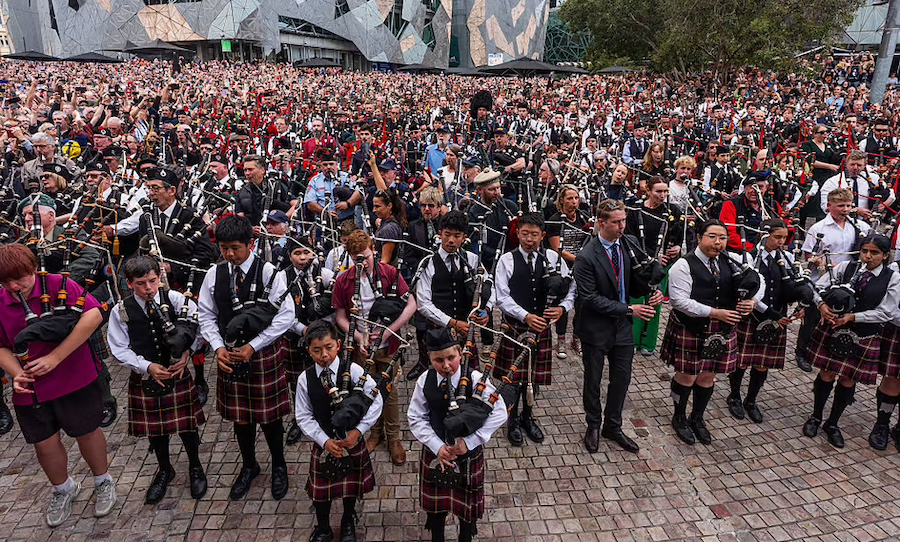Exhibiting at the recent PAX conference, 64 Ways of Being is a game for mobile that offers up a unique perspective of Melbourne. It’s facilitated by augmented reality and a blend of composer-created ambient score and incidental sounds of the environment.
Set for launch later this year, the app transforms Melbourne into a playable city. The player can connect with the city in 64 locations via augmented reality, offering up a new way to discover the city’s diverse characters.
The collaborators behind this immersive experience: artist and game creator Troy Innocent and live arts group one step at a time like this – comprised of Clair Korobacz and Julian Rickert – took time to tell us about the interdisciplinary collaboration and sensual engagement with urban landscapes that are the hallmarks of 64 Ways of Being.
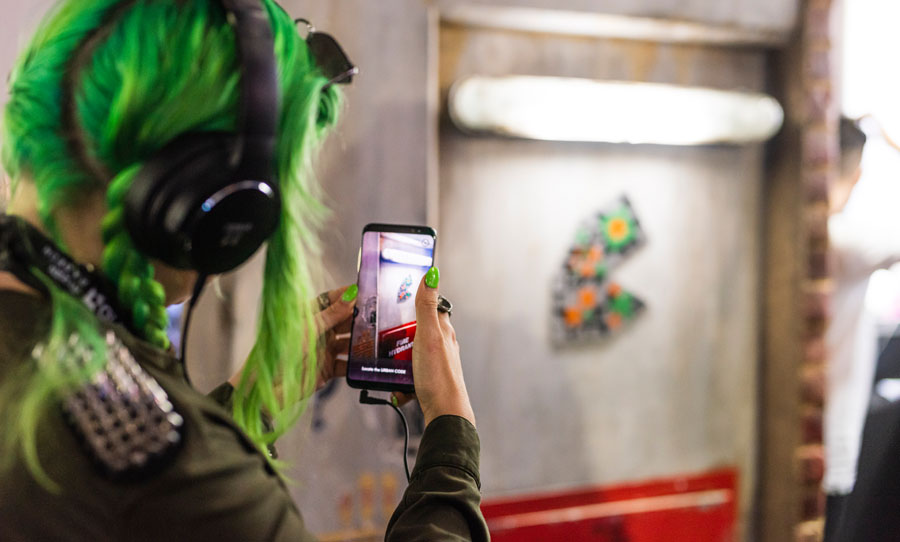
We took five with the creators of 64 Ways of Being: an augmented reality app that sparks a new dialog between the public and the city of Melbourne.
ENMORE AUDIO: What sparked the concept for 64 Ways of Being?
TROY: I’ve been working with urban play as a way for people to reconnect, reimagine and reconfigure their relationship to the world over the past ten years or so. Last year, while researching playable cities during a City of Melbourne Knowledge Fellowship and observing players engaged in my urban codemaking game Wayfinder Live, I became curious about the connections between play, language and immersive audio.
Wayfinder Live blends physical objects with digital interfaces to reimagine everyday urban environments in playful ways, allowing players to decode their city, to understand and connect with it on a deeper level.
Playable cities now have the opportunity to make the city itself a platform for play – through radical interventions into the democratic use of data and social frameworks that connect people, place, technology and code. They allow people to reimagine the city, not to just to see the city-as-it-is but to experience the city-as-it-could-be.
Responding to Melbourne as a playable city, the challenge was to find a way to bring the creative, linguistic, cultural, social and urban diversity of the city into the experience. These ways of being aim to capture this diversity and expand the player’s relationship to their world. We want to bring these into being, to allow players to reimagine their world through urban play.
I’ve had a longstanding interest in the connection between language and the ways in which we build our world. In this project, the emotional cartography of the city is mapped via 64 words from 64 languages that describe different ways of being. Each is represented by an ideogram that connects them and that appears in different public artworks – as signs and markers on the street for example.
ENMORE AUDIO: What disciplines did you bring to the development of the app?
TROY: Exploring the potential of urban play requires experts from a diverse range of disciplines including urban design, live art, computer science, ethnographic research, game design, public art, theatre, architecture, live art, sound art, and many more.
Collectively, urban play communities work together to playtest, workshop, design, develop and realise opportunities for play in the city ranging from experiments and prototypes through to large-scale collaborations like 64 Ways of Being.
The work is conceived as a collaboration and conversation across public art, game design and live art. Public art brings into the mix place and language, and provocations on ways of being in the world. Live art immerses the player within experiential storytelling and evocative soundscapes, holding them within an alternate world.
Game design blends and connects these by providing a platform for experiences, and another world again that embeds and implicates the player within the action of a playable city – another place of possibility altogether.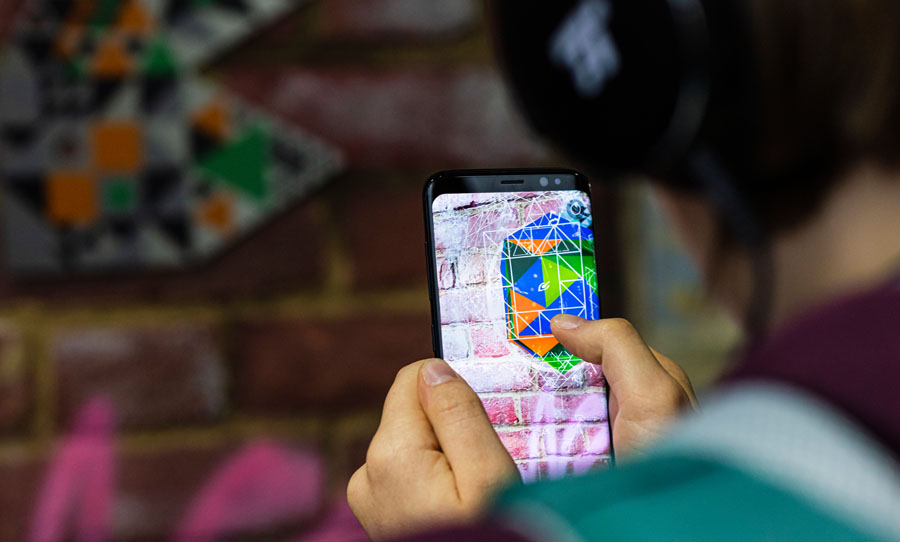
ENMORE AUDIO: Is it a small or big team working on the app? What skills do they bring to this project?
TROY: Overall, there are about ten people working on the app with a diverse range of expertise. Game development is inherently interdisciplinary, and working with playable cities even more so. Many people working on the project have multiple skillsets, which is important both to realise the project and also when developing a shared language for talking about the collaboration.
For example as an artist, designer, coder, academic and educator I’m often translating between different knowledge domains. Millipede bring expertise in game development, project management, user interface design, animation and mobile app design.
one step at a time like this is a live arts collective that brings experiential storytelling, immersive audio and expertise in theatre and dramaturgy into the mix. Collectively, we form a diverse team that is quite unique in the game dev space. Behind the scenes, the process of bringing the app into being is also a creative experiment as much as the app itself.
ENMORE AUDIO: The experience of 64 Ways evokes a feeling of magic – creating new objects out of the ether. If possible, could you describe the relationship between coding and augmented reality?
TROY: I’m glad you feel that way, the urban code experience at PAX was a way to bring the various creative elements of the project together into an experience that spoke to the city (or the fragment of the city that we brought with us) as we know it but also bringing into being something more – creatures and entities that we feel but can’t see or hear – and make them tangible through synaesthetic play.
I’m really interested in geometric abstraction in connection with music to create internal emotional states. Games offer a way to bring these different creative languages together in unexpected and imaginative ways that can create new types of experience – this is what really interests me in working with urban code and augmented reality.
Using this city as a material for creating ‘ways of being’ and drawing people into these through the ‘liveness of play’ we will create situations and encounters in the city. Each way of being is a live, realtime, interactive encounter that is intimate, particular and participatory – the player being there makes a difference.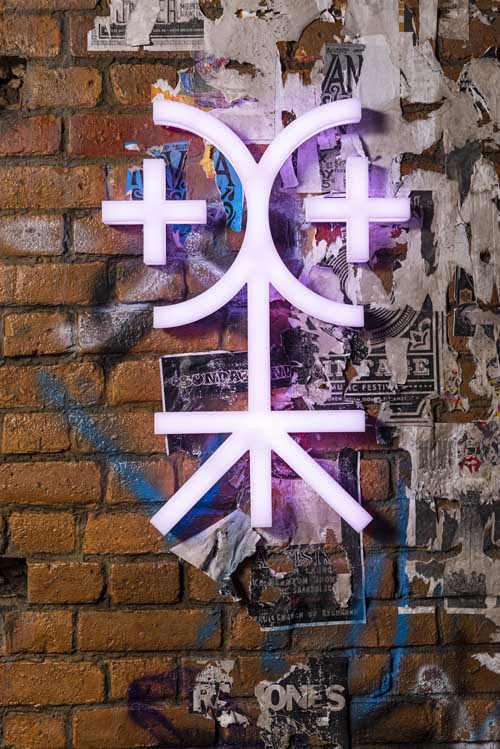
Experiencing the work shifts between two different modes of engagement: walking and listening, and experiencing a way of being within a particular time and place. These live encounters are situated spatially in an augmented reality street theatre environment that explores the creative potential of the platform to manifest ways of being.
As people and place come together they engage in a conversation with the city – by following characters, activating architecture, discovering hidden worlds, playing with strangers, and talking with the non-human world like trees and rivers. All of these experiences are situated in a shared story world that responds to individual player behaviour and participation – where they are, where they have been, and where they are going shapes their particular conversation with the city.
ENMORE AUDIO: What are your plans for the future?
TROY: We are playtesting an early access build of the game with a diverse mix of people soon before launching into a full build of the entire content in 2020. There was a lot of interest at PAX on taking the concept to other cities and would love to explore that as taking earlier games like Wayfinder Live to places like Bristol, Barcelona, Hong Kong, Istanbul and Ogaki introduced me to a wide range of urban environments, expanding my understanding of urban play.
As we get closer to a public launch we’ll be sharing a lot on social media, and talking more broadly to urban play communities including public events that talk more broadly to the themes of Playable City Melbourne.
With this larger project, I’m looking to draw upon my experience and networks with universities to share my knowledge on urban play and commission some further projects. I’m also keen to get back to my playable art tram and see if I get this running on other cities in the world.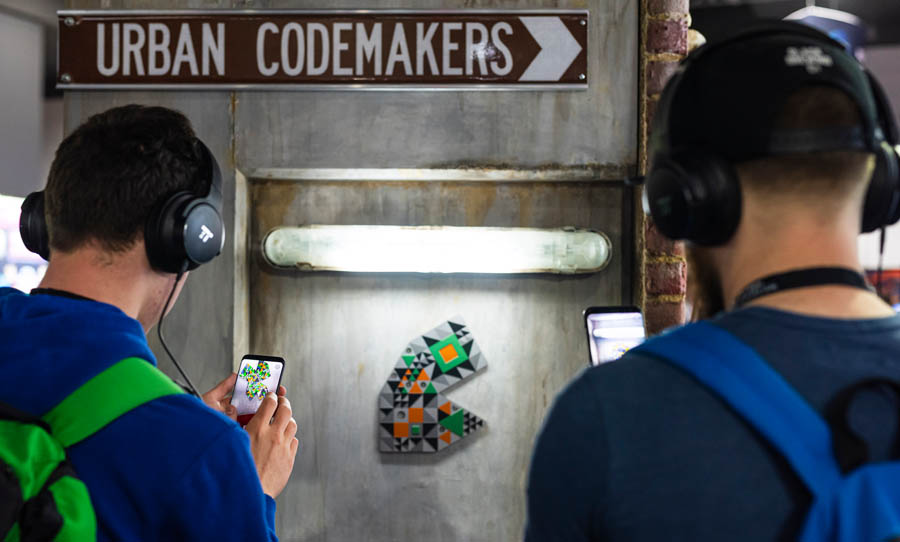
The team from one step at a time like this spoke to us about the role that audio played within 64 Ways of Being.
ENMORE AUDIO: How did one step get involved in the project?
JULIAN: Troy had experienced one of our previous works which was a complete overhaul of a Shakespeare play, that involved people following a character on their phone screen through a series of locations in the city, which matched the locations in the play. It was an immersive walking experience where one at a time, audience members could be in the situations that the main characters.
CLAIR: With that work, we were mainly using film and audio, so we had a basic app that the audience followed on a phone. It wasn’t so much a game as it was a contemporary performance piece. We have a theatre background, but we’ve moved into more site-specific work and journey based audio pieces.
Troy experienced our Shakespeare work, so when he came up with the concepts for 64 Ways, he thought of us immediately.
JULIAN: This is the first experience we’ve had of creating it the game world – that’s one of the exciting things about it, it brings different disciplines together.
CLAIR: We’ve always used user-friendly technology, whether it’s an iPod that the audience operates themselves or a very basic video app, but this another level of incorporating technology into the experience. 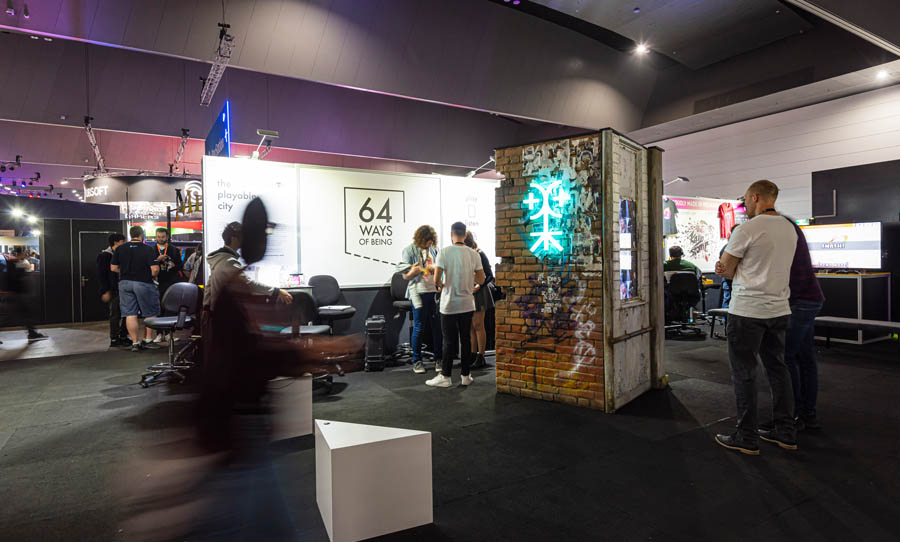
ENMORE AUDIO: In using this technology, there are fewer barriers to entry.
CLAIR: Yes, we hope that it will reach a fairly broad audience, like a mix of performance-goers, tourists and gamers.
ENMORE AUDIO: The sonic landscape of the app is beguiling – there are meditative and mysterious elements at play, so what inspired your choices for the sounds on 64 Ways?
CLAIR: The player is looking, listening and exploring and then there are moments when the augmented reality comes in to play and opens up the world further, through how you interact.
JULIAN: The sound component of the walking and looking, that immersive aspect primes player so that when the augmented reality encounter occurs, it makes sense to them. 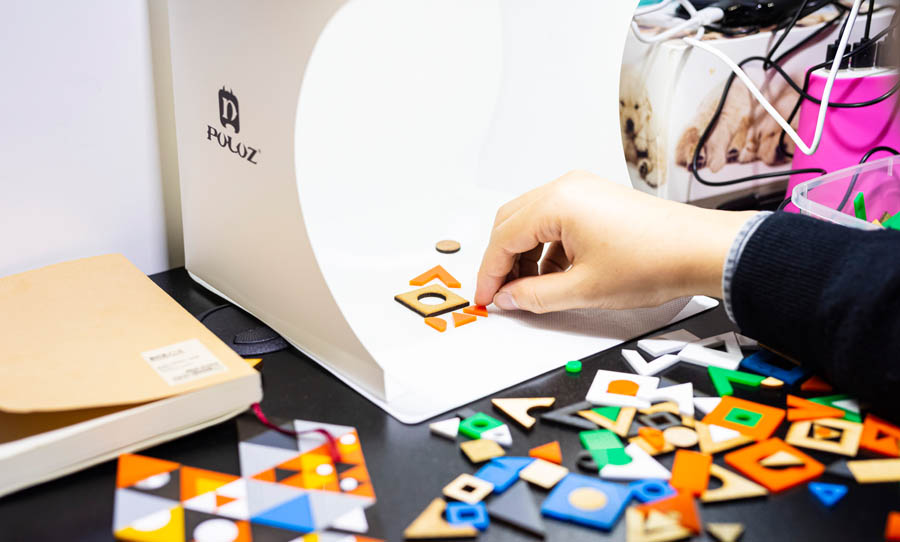
ENMORE AUDIO: I noticed that when I was playing with it, it had a generative aspect. For example, when you played a melody, the app would reply.
CLAIR: Yes, an echo of what you had done.
ENMORE AUDIO: Yes, an echo and elaboration as well.
JULIAN: For us, the importance of that is that the player feels that their actions mean something, it’s very clear action and response, it makes a difference whether I’m there or not, or whether I do this or that.
CLAIR: I think with that particular experience or encounter when we look to develop it further, we would like there to be more space around the playing, so it’s not just like you’re going to different levels, but the player really starts to be more creative in the way that they play the instrument.
JULIAN: The temptation is to keep pressing the buttons, but we’d like to make it so if you just press one or two buttons, it will give you enough space to realise that there’s a whole world opening up in front of you. Our goal is to open it up so that each level is musically satisfying.
CLAIR: We’d like to shift instruments as the levels change, so there’s a more clear sonic contrast, so as you progress through the game, there’s a clear sense of the music shifting with it.
We’re hoping that with the augmented reality encounters, that the player starts to feel like they’re interacting with the world and it’s talking back to them. Hence, the urban code of having a character that you can speak to and it’s speaking back to you and you’re helping it and having some sort of relationship.
JULIAN: it’s beyond just learning the notes.
ENMORE AUDIO: What kind of tools are used you create the interaction between the app and the player?
CLAIR: Millipede is the app company that specialises in the technical development of the app. We basically supply all the soundscapes, the voice, the music, the narrative.
JULIAN: We’re trying the make the whole sense of a journey for the player.
ENMORE AUDIO: What is the basis for the musical input?
JULIAN: Troy knows his way around Ableton Live quite well, I’m getting my way around it somewhat, but Ableton is the basis of the sound generation.
CLAIR: Also, the way that we create soundtracks is through local music. With the soundscape, we’re drawing on local, Melbourne underground ambient musicians – it’s a whole world! We often use extant music that we find then ask the musicians if we can use the piece.
Then it’s how we might blend that with another piece and how it enhances the location of that the player’s in. So, it will be a very ‘Melbourne’ experience in the end. We would be linking to all those musicians, so the player can go back and find out more about where the music came from.
Then there would be other moments when the player is generating the sound, using the pallet that we have provided. 
ENMORE AUDIO: Even though the player can go in any direction they like, is there any way that you can map out the narrative?
CLAIR: We are guiding them to very specific places, then they interact and what happens in those moments of interaction is up to the player, but of course, the atmosphere that we’ve created from the sounds that we’ve chosen is also guiding the player’s experience. We’re curating the atmosphere and which location they’re having the experience.
ENMORE AUDIO: Do you have any future plans to work in this field, or other ambitions for your work?
JULIAN: Our ambition to try and finish this one! We’ve never worked quite this way before, so it’s exciting for us. I think the three different groups are trying hard to understand different languages, timelines – theatre people are different from app developers and game designers. I hope that it will broaden our experience and our pallet quite a lot, so we can imagine what will come next.
To stay up to date with the development of 64 Ways of Being, go to the website and follow the project on Instagram and Twitter.

